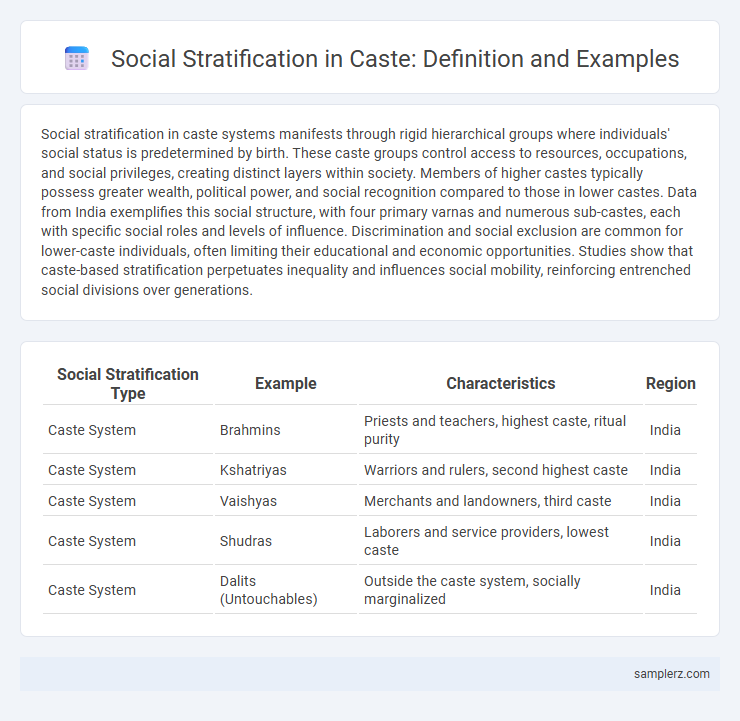Social stratification in caste systems manifests through rigid hierarchical groups where individuals' social status is predetermined by birth. These caste groups control access to resources, occupations, and social privileges, creating distinct layers within society. Members of higher castes typically possess greater wealth, political power, and social recognition compared to those in lower castes. Data from India exemplifies this social structure, with four primary varnas and numerous sub-castes, each with specific social roles and levels of influence. Discrimination and social exclusion are common for lower-caste individuals, often limiting their educational and economic opportunities. Studies show that caste-based stratification perpetuates inequality and influences social mobility, reinforcing entrenched social divisions over generations.
Table of Comparison
| Social Stratification Type | Example | Characteristics | Region |
|---|---|---|---|
| Caste System | Brahmins | Priests and teachers, highest caste, ritual purity | India |
| Caste System | Kshatriyas | Warriors and rulers, second highest caste | India |
| Caste System | Vaishyas | Merchants and landowners, third caste | India |
| Caste System | Shudras | Laborers and service providers, lowest caste | India |
| Caste System | Dalits (Untouchables) | Outside the caste system, socially marginalized | India |
Understanding Social Stratification: The Caste Perspective
In the caste system, social stratification manifests through rigid hereditary divisions that dictate individuals' social status, occupation, and potential for upward mobility. This hierarchy is often reinforced by cultural norms, religious beliefs, and legal codes, maintaining distinct social groups with varying degrees of power and privilege. Understanding caste-based stratification reveals the complexities of social inequality and its deep-rooted impact on access to resources and social interactions.
Historical Roots of Caste-Based Stratification
Caste-based stratification in India originated from ancient Vedic society, where occupations and social duties were divided into four main varnas: Brahmins, Kshatriyas, Vaishyas, and Shudras. This hierarchical system solidified over centuries through religious doctrines and social customs, embedding inequalities and hereditary status distinctions deeply into the social fabric. Historical texts like Manusmriti codified rules that maintained caste boundaries, perpetuating social exclusion and limited mobility.
Caste Hierarchy: Structure and Social Roles
Caste hierarchy in social stratification organizes individuals into rigid, hereditary groups based on occupation and social status, such as Brahmins (priests), Kshatriyas (warriors), Vaishyas (traders), and Shudras (laborers). Each caste occupies a distinct social role, reinforcing systemic inequalities and limiting mobility. This structured division perpetuates social roles and interactions that influence power dynamics within communities.
Economic Implications of Caste Divisions
Caste-based social stratification significantly impacts economic opportunities, limiting access to resources, education, and employment for lower caste groups. Economic disparities are perpetuated as higher castes often control land, capital, and key industries, reinforcing wealth concentration along caste lines. This systemic exclusion inhibits upward mobility and sustains poverty cycles within marginalized communities.
Caste and Educational Opportunities
Caste-based social stratification significantly impacts educational opportunities, with lower castes often facing systemic barriers such as limited access to quality schools and resources. These educational disparities perpetuate socio-economic inequalities, restricting upward mobility for marginalized groups. Affirmative action policies and scholarship programs are crucial in addressing these entrenched educational gaps within caste hierarchies.
Social Mobility Barriers within Caste Systems
Social mobility barriers within caste systems manifest through rigid hereditary hierarchies that restrict access to education, employment, and social networks, reinforcing economic disparities across generations. Endogamous marriage practices and occupational segregation institutionalize status quo, limiting upward mobility for lower-caste individuals. Such systemic constraints perpetuate inequality and hinder social integration in caste-based societies.
Interpersonal Relationships Shaped by Caste
Interpersonal relationships in caste-based social stratification often dictate social interactions, marriage choices, and community affiliations, reinforcing caste boundaries. Individuals typically form bonds within their own caste, strengthening social cohesion and perpetuating inequality. These caste-driven social networks influence access to resources, social support, and opportunities, deeply embedding social hierarchy.
Caste in Urban vs Rural Societies
Caste in urban societies often manifests through subtle social networks and economic opportunities, whereas in rural areas, it remains more rigidly defined by traditional roles and community interactions. Urbanization promotes some degree of caste mobility due to diverse occupational options and increased social mixing, but caste-based discrimination can still influence housing, marriage, and employment. Rural caste systems continue to dictate social hierarchy, resource access, and political power with deeply entrenched customs and local governance.
Legal Frameworks Addressing Caste-based Discrimination
Legal frameworks addressing caste-based discrimination include constitutional provisions such as Article 15 and Article 17 of the Indian Constitution, which prohibit discrimination and outlaw "untouchability." The Scheduled Castes and Scheduled Tribes (Prevention of Atrocities) Act, 1989, offers specific protections and penalties to combat caste-based offenses. Enforcement mechanisms like tribunals and affirmative action policies reinforce social equity for historically marginalized caste groups.
Modern Movements Challenging Caste Stratification
Modern movements challenging caste stratification in India, such as the Dalit Panthers and Ambedkarite groups, actively advocate for social equality and the abolition of caste-based discrimination. These movements leverage legal reforms, educational initiatives, and political participation to dismantle entrenched social hierarchies. Increased awareness through social media platforms has amplified their impact, promoting broader societal recognition of caste injustices.

example of social stratification in caste Infographic
 samplerz.com
samplerz.com